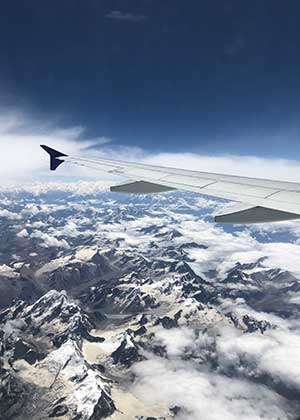During the summer, ¸Ô±¾ÊÓƵ students applied their liberal arts know-how in a variety of real-world settings. They continue to update the university community on their experiences. Here, Patrick Needham ’20, a biochemistry major from Vermilion, Ohio, writes about his work with neurology patients in Leh, Ladakh, India — an opportunity supported by . A version of this essay originally appeared at ladakhneurology.org.

On his way to India (Photo by Patrick Needham ’20)
Flying into the airport in Leh, Ladakh, India, I became aware of how remote and beautiful this high-altitude environment would be. As I looked out the window of the airplane, I could see the Himalayas, the Indus River Valley, and an arid desert. The scenery was absolutely breathtaking.
Within the first few minutes of my time in Leh, I knew that my experience would be as striking as the landscape. Throughout my life, I have had the opportunity to experience western medical practices. I was excited with the prospect of observing the difference between western medicine and the medicine in Leh.
With sponsorship and promotion assistance from Rimo Expeditions, the camp is conducted by the Ladakh Institute for Prevention, which provides basic medical service to the people of Ladakh year-round and hosts medical specialists.
The people who attended the camp traveled from all around the region of Ladakh. Patients brought CT Scans, X-Rays, and MRIs. Camp neurologists would interpret the results and use the information to supplement or change diagnoses and assess treatments.
During the clinic, I prepared patients and ran 15-minute electroencephalograms (EEGs). In the United States, EEGs are usually a very time-intensive examination of the electricity within the brain. At the shortest intervals, EEGs are conducted for at least an hour. Because of the number of patients being seen throughout the course of the clinic, extended EEGs were not possible at Ladakh.
Rather than applying individual probes, we used electrode caps because they greatly expedited the patient preparation process. If individual electrodes were used, then a glue would have been necessary, and this would have been much harder on patients coming in for a 15-minute EEG.
Throughout the clinic, I conducted 38 EEG studies, which doctors then screened to see if there was any seizure activity during the 15-minute interval.
The people of Ladakh are not more prone to exhibit neurological abnormalities compared to the population seen by the neurologists in the United States. The only difference in the patient populations is that, due to their remote geographic location, the people of Ladakh are only able to receive conclusive diagnoses and specialized treatment through this yearly clinic.
The physicians who attend the clinic do so much good for the region of Ladakh. I would tell anyone considering attending the clinic that they should do so — that they will not regret it. For me, I will always remember my time in Leh fondly. I am — and always will be — thankful to have been able to attend the camp.
Related:
